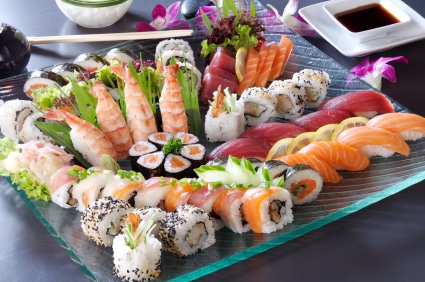
The first thing to realize is that there is omakase and there is omakase. By that I mean in many areas, omakase has begun to become popular and the concept has become a diluted experience due to less experienced restaurants jumping on the bandwagon. True omakase should result in careful attention by the Itamae, a great selection of the freshest fish, seasonal items that you might not normally even encounter and a presentation far beyond what you would ever see just ordering a few pieces of sushi.
You might be used to your yellowtail (hamachi) in a roll with scallions, or as sushi, but have you ever had it cubed and served with a raw quail egg and tobiko? I have seen plenty of omakase platters with new and interesting presentations, as well as unique combinations. However in some cases, where lesser understanding results in a lower quality experience, what you may end up with is a bunch of sushi items that someone else chose on a plate, perhaps still tasty, but is not that dissimilar to what you normally see in an average order.
In bad sushi restaurants it could be a great way for the Itamae hand of items that he may want to be rid of. Stick to respectable places and you won’t have to worry about that. With true omakase, the Itamae should be attentive to you and not just hand you a plate and wander off. Traditional omakase is also not based on a particular budget, it can be a costly adventure but well worth it if the Itamae is highly skilled.
Some feel that it is best to not have omakase at a place where the Itamae does not know your likes and dislikes, however I feel that the true reason for omakase is to be able to experience the best items that are available at that time, and in that case, knowing you is irrelevant since it is more about what is best at that moment than what you like. If you only like California rolls and spicy tuna, omakase is something you might want to skip. However it is also a great way to discover new sushi items that you may have overlooked or never thought to try.
If you are new to omakase, you might want to keep in mind what to expect from your meal. You must be prepared to eat things that you may have never wanted to try or look like something you may never want to. Generally, it is not considered polite to leave food on your plate, but then again, no one is holding a gun to your head. On the other hand, it is not impolite to say to the Itamae something like “Omakase, please, but no mackerel.” You can choose to not have sashimi, no sushi, or both if you would like. Making requests is all part of the Itamae being attentive to you.
In general, it is best to order omakase at a restaurant that you know. Or one that is well known to serve excellent omakase. This serving style can be easily found, but to expect great omakase in a standard sushi place would be a mistake. It is easy to find good sushi, but omakase takes the experience to a whole new level. It takes years of experience, deep knowledge of the food, and devotion to creating the best meal for the customer that makes omakase great. Anything else is simply someone else’s order.
I have always been fascinated by the creation and culture of different foods, particularly sushi and sashimi in the modern era of Japanese cuisine. I am a classically trained chef and sushi connoisseur, also having operated a food service company and enjoy investigating and experimenting with food around the world.
Thanks! Very informative blog – My wife and I jumped into the world of sushi a few months ago and have been exploring without a guide. We’re now at the point where having knowlege beyond the menu is the best part of the experience. Will try omakase!
In having this conversation with one of the top sushi chefs in California (and in that circle they only recognize about 10 in the state) we discussed what exactly Omakase is and is not. It is certainly chef’s choice, and a showcase of talent. It is not something you can just go up and order. In true Omakase ordering there must be a relationship in place between the two parties, with most likely 5-6 visits under your belt before ordering Omakase. This is a key point, not often picked up by dictionaries and lost in translation. But if you are lucky enough to build a strong relationship with your sushi chef, and he is a traditional japanese Itamae, you will have the best of the best and it can cost from 100 to 800 per person depending on your appetite. The process consists of approximately 2 hours, and 7-12 courses, depending on the portion size of each dish.
I have had Omakase at several different restaurants, in both Indonesia and the USA. Both were different experiences, Indonesia served me until I said stop and the restaurant in California only consisted of 6 dishes. is omakase considered all you can eat. In the sense that you tell the sushi chef when you are full and do not want any more? I’ve heard both
There really is no rule for omakase dining. Some restaurants have a prix fixe and you receive a certain number of items for X amount of money, while others will simply charge you for each item, and the itamae will keep it coming until you say you are content. I’ve been to both kinds of restaurants myself, and have really noticed no consistency with one exception. If you are sitting at the sushi bar, you may find it more common for the sushi chef to keep the food coming.